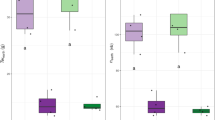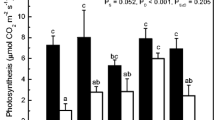Summary
The physiological activity and C and N allocation of beech seedlings planted in two different beech forest soils (acid brown earth, rendzina) were studied over 80 days. One adult earthworm Octolasion lacteum (Örley) was placed in half of the containers. Transpiration, CO2, assimilation, chlorophyll synthesis and N incorporation were higher in the acid brown earth than in the rendzina. Fine root production was also higher in the acid brown earth. Production of stems and total N incorporation were higher in the O. lacteum treatments than in the controls. Burrowing activity of O. lacteum did not affect total root production but stimulated the transfer of C and N towards aboveground parts of the plants and shifted the large root to fine root ratio towards large roots. O. lacteum effects were similar in both soils. It is concluded that endogeic earthworms significantly affect resource allocation patterns of beech seedlings over a wide range of soils. This effect can be partly explained by an increased availability of N in soils worked by earth-worms.
Similar content being viewed by others
References
Aber JD, Melillo JM, Nadelhoffer KJ, McClaugherty CA, Pastor J (1985) Fine root turnover in forest ecosystems in relation to quantity and form of nitrogen availability: a comparison of two methods. Oecologia 66:317–321
Aldag R, Graff O (1975) Einfluß der Regenwurmtättigkeit auf Proteingehalt und Proteinqualität junger Haferpflanzen. Landwirtsch Forsch 31/II:277–284
Anders S, Hofmann G, Unger S (1985) Quantifizierung der Leistungspotenz natürlicher Standortproduktivität für die Rohholzerzeugung anhand ökologischer Ertragsmodelle — dargestellt am Beispiel natürlicher Buchenwälder des unteren Berglandes. Beitr Forstwiss 19:97–109
Anderson JM, Leonard MA (1988) Tree root and macrofauna effects on nitrification and mineral nitrogen losses from deciduous leaf litter. Rev Ecol Biol Sol 25:373–384
Atlavinyte O, Bagdonavicience Z, Budviciene L (1968) The effect of Lumbricidae on the barley crops in various soils. Pedobiologia 8:415–423
Bouché MB (1977) Stratégies lombriciennes. Ecol Bull 25:122–132
Clarholm M (1985) Possible roles for roots, bacteria, protozoa and fungi in supplying nutrients to plants. In: Fitter AH, Atkinson A, Read DJ, Usher MB (eds) Ecological Interactions in Soil. Blackwell Scientific Publications, Oxford, pp 355–365
Duff HA (1958) Pasture improvement in low altitude tussock and shrub-land. N Z Grassl Ass Proc 20:70–79
Edwards CA, Lofty JR (1980) Effects of earthworm inoculation upon the root growth of direct drilled cereals. J Appl Ecol 17:533–543
Ellenberg HH (1988) Vegetation Ecology of Central Europe. Cambridge University Press, Cambridge, 731 pp
Graff O, Mackeschin F (1980) Beeinflussung des Ertrages von Weidelgrass (Lolium multiflorum) durch Ausscheidungen von Regenwürmern dreier verschiedener Arten. Pedobiologia 20:176–180
Hoogerkamp M, Rogaar H, Eijsackers HJP (1983) Effect of earthworms on grassland and recently reclaimed polder soils in the Netherlands. In: JE Satchell (ed) Earthworm Ecology. Chapman and Hall, London, pp 85–105
Judas M (1989) Populationsökologie der Regenwürmer (Lumbricidae) in einem Kalkbuchenwald: Abundanzdynamik und Bedeutung von Nahrungsressourcen. Ber Forschungszentrums Waldökosysteme (A) 53:1–140
Kuikman PJ, van Veen JA (1989) The impact of Protozoa on the availability of bacterial nitrogen to plants. Biol Fertil Soils 8:13–18
Lal R (1988) Effects of macrofauna on soil properties in tropical ecosystems. Agric Ecosystems Environ 24:101–116
Lee KE (1985) Earthworms. Academic Press Australia, Sydney, 411 pp
Marshall VG (1971) Effects of soil arthropods and earthworms on the growth of black spruce. In: d'Aguilar J (ed) IV. Colloqium pedobiologiae. Institut National des Recherches Agriculturelles Publ 71-7, Paris, pp 109–177
Nadelhoffer KJ, Aber JD, Melillo JM (1985) Fine roots, net primary production, and soil nitrogen availability: a new hypothesis. Ecology 66:1377–1390
Nielson RL (1951) Earthworms and soil fertility. Proc 13th Conf NZ Grassl Assoc, New Plymouth: 158–167
Pearcy RW, Bjorkmann O, Caldwell MM, Keeley JE, Monson RK, Strain BR (1987) Carbon gain by plants in natural environments. Bioscience 37:21–29
Rhee JA van (1977) A study of the effect of earthworms on orchard productivity. Pedobiologia 17:107–114
Rozen A (1988) The annual cycle in populations of earthworms (Lumbricidae, Oligochaeta) in three types of oak-hornbeam of the Niepolomicka Forest (Poland) II. Dynamics of populations, numbers, biomass and age structure. Pedobiologia 31:169–178
Schaefer M (1990) The soil fauna of a beech forest on limestone: trophic structure and energy budget. Oecologia 82:128–136
Scheu S (1987) Microbial activity and nutrient dynamics in earthworm casts (Lumbricidae). Biol Fertil Soils 5:230–234
Scheu S, Wolters V (1991) The influence of fragmentation and bioturbation on the decomposition of C-14-labelled beech leaf litter. Soil Biol Biochem: in press
Schulze E-D (1970) Der CO2-Gaswechsel der buche (Fagus sylvatica L.) in Abhängigkeit von Klimafaktoren im Freiland. Flora 159:177–232
Schulze E-D, Hall AE, Lange OL, Walz H (1982) A portable steady state porometer for measuring the carbon dioxide and water vapour changes of leaves under natural conditions. Oecologia 53:141–145
Springett JA, Syers JK (1979) Effect of earthworm casts on ryegrass seedlings. Proc 2nd Australasian Conf Grassld Invertebr Ecol: 44–47
Stickan W (1989) Auswirkungen von Düngungs-und Kalkungsmaßnahmen auf den CO2-und H2O-Gaswechsel von Buchen (Fagus sylvatica L.) im Solling. Verh Ges Ökologie 17:497–506
Stickan W, Schulte M, Kakubari Y, Niederstadt F, Schenk J, Runge M (1991) Ökophysiologische und biometrische Untersuchungen in einem Buchenbestand (Fagus sylvatica L.) des Sollings als ein Beitrag zur Waldschadensforschung. Ber Forschungszentrums Waldökosysteme (B) 18:1–81
Tomati U, Galli E, Grapelli A, Di Lena G (1990) Effect of earthworm casts on protein synthesis in radish (Raphanus sativum) and lettuce (Lactuca sativa). Biol Fertil Soils 9:288–289
Trigo D, Mato S, Souto BF, Diaz Cosin DJ (1989) Earthworms of continental Portugal — relationships with soil factors. Boll Zool 56:327–332
Wolters V (1983) Ökologische Untersuchungen an Collembolen eines Buchenwaldes auf Kalk. Pedobiologia 25:73–85
Wolters V (1989) The influence of omnivorous elaterid larvae on the microbial carbon cycle in different forest soils. Oecologia 80:405–413
Wolters V (1991) Soil invertebrates-effects on nutrient turnover and soil structure. Z Pflanzenern Bodenk: in press
Wolters V, Joergensen RG (1991a) Microbial carbon turnover in beech forest soils at different stages of acidification. Soil Biol Biochem: in press
Wolters V, Joergensen RG (1991b) Microbial carbon turnover in beech forest soils worked by Aporrectodea caliginosa (Savigny) (Oligochaeta, Lumbricidae). Soil Biol Biochem, in press
Wolters V, Stickan W (1991a) Effects of an endogeic earthworm species on transpiration and C-allocation of beech (Fagus sylvatica L.) seedlings. Ber Forschungszentrums Waldökosysteme (B) 22:383–386
Wolters V, Stickan W (1991b) Octolasion lacteum (Örley) (Lumbricidae, Oligochaeta) effects on microbial C and N turnover in two beech forest soils-relationship to plant growth. Oecologia (in press)
Ziegler H, Egle K (1965) Zur quantitativen Analyse der Chloroplastenpigmente. Beitr Biol Pflanzen 41:11
Zrazhevskii AI (1958) Earthworms and the interrelations of tree and shrub species. Priroda (Moscow) 47:96–98
Author information
Authors and Affiliations
Rights and permissions
About this article
Cite this article
Wolters, V., Stickan, W. Resource allocation of beech seedlings (Fagus sylvatica L.) —relationship to earthworm activity and soil conditions. Oecologia 88, 125–131 (1991). https://doi.org/10.1007/BF00328412
Received:
Accepted:
Issue Date:
DOI: https://doi.org/10.1007/BF00328412




